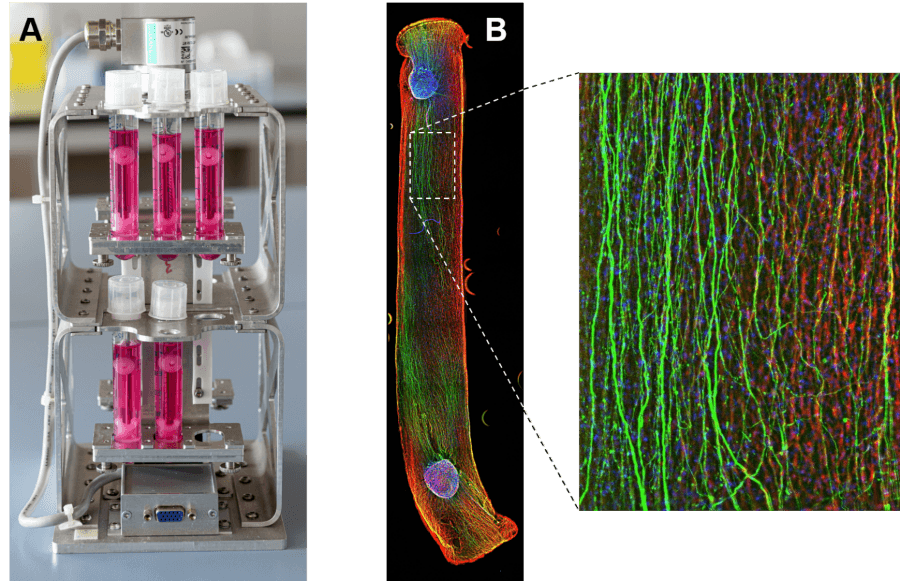UAS Technikum Wien conducts research on artificial nerve grafts

30 May, 2023
New approaches in the therapy of peripheral nerve injuries as well as a possible alternative to animal experiments.
A team of researchers at the FH Technikum Wien is working on promising artificial nerve grafts to treat peripheral nerve injuries. In addition, the developments at the Technikum can help to reduce animal testing.
Peripheral nerve injuries are nerve injuries outside the brain, for example in the nerves of the hand, for example due to an accident. Such damage significantly affects the quality of life of patients and can lead to the loss of motor and sensory functions. Current therapy is based on nerve grafts from the patient’s own body, but this involves loss of function of the donor nerve – sacrificing a healthy nerve to restore the function of the injured nerve.
“There is an urgent need for alternative therapies, such as the production of artificial nerve grafts, which my team has set itself the goal of researching and developing,” says Andreas Teuschl-Woller, head of the research focus Tissue Engineering & Molecular Life Science Technologies at UAS Technikum Wien.
Innovative approach with patent application
Researcher Carina Hromada is pursuing an approach that takes the natural regeneration processes in the body after nerve injuries as a model. After nerve injuries, so-called glial cells (also called “Schwann cells”) can form longitudinal cell tracks (Büngner’s ligaments) between the severed nerve endings, which serve as guide structures for regenerating, regrowing axons.
In detail:
Carina Hromada is exploring the approach of engineering longitudinally aligned Schwann cells in a biocompatible matrix.
For these artificial Büngner tapes, Schwann cells are embedded in three-dimensional protein hydrogels, applied to a special hook holder and then mechanically trained using the “MagneTissue” bioreactor developed in-house.
Schwann cells can thus be subjected to tensile stress by interacting a magnet integrated into the hook holder with an external motor-controlled magnet of the bioreactor (Fig. 1A).
This leads to longitudinal alignment along the tensile axis and formation of a specific regenerative phenotype of Schwann cells, as also found in Büngner tapes.
The innovative idea of aligning Schwann cells with the help of active mechanical stimulation was internationally protected by the research team of the FH Technikum Wien with a patent application.
New regeneration model
In order to be able to predict the regenerative capacity of artificial nerve grafts in the body, Hromada is also working on establishing a cell-based regeneration model for peripheral nerves, which is intended to mimic the regenerative processes after injuries outside the body.
In detail:
This involves combining Schwann cell constructs with dorsal root ganglia and examining the outgrowth of axons along previously aligned Schwann cells.
It was shown that regenerating axons orient along the artificial Büngner ligaments, as hoped, and thus successfully innervate the construct (Fig. 1B) – and this could thus represent a promising alternative to autologous grafts in the clinic in the future.
The long-standing collaboration with the Ludwig Boltzmann Institute (LBI) for Traumatology (the research center in cooperation with AUVA), specifically with the neuroregeneration group of David Hercher, allows to bring the research results into a clinical context. This is an essential step to develop such cell-based therapies specifically for their clinical use.
Further opportunities, among others, in reduction of animal experiments
The above-mentioned nerve-like axon-Schwann cell constructs offer a variety of further possibilities that are currently being tested. Currently, the combination with macrophage models is being worked on within the framework of the City of Vienna project “ImmunTissue” (MA23 30-06), which will serve to further evaluate the constructs. These models also have further relevance for research and clinical application as a possible drug screening platform to detect potentially neurotoxic effects of new and established drugs (which are e.g. used as specific chemotherapeutic agents). This can not only significantly reduce animal testing and associated costs, but also better predict the success of clinical trials.
Pictured: Development of artificial Büngner tapes. Image A: The “MagneTissue” bioreactor is used to longitudinally align Schwann cells in protein hydrogels using two magnets. Figure B: The artificial Büngner’s ligaments are tested in a regeneration model with regard to their regenerative capacity. Axons (green) grow as hoped along the longitudinally aligned Schwann cells (red); blue: cell nuclei. Copyright for both images: FH Technikum Vienna.
Links/ Scientific Publications
- [1] https://www.technikum-wien.at/forschungsschwerpunkt-tissue-engineering-molecular-life-science-technologies/
- [2] https://www.technikum-wien.at/personal/carina-hromada
- [3] Heher P, Maleiner B, Prüller J, Teuschl AH, Kollmitzer J, Monforte X, Wolbank S, Redl H, Rünzler D, Fuchs C. A novel bioreactor for the generation of highly aligned 3D skeletal muscle-like constructs through orientation of fibrin via application of static strain. Acta Biomater. 2015 Sep;24:251-65. doi: 10.1016/j.actbio.2015.06.033. Epub 2015 Jun 30. PMID: 26141153.
- [4] Tomasch J, Maleiner B, Hromada C, Szwarc-Hofbauer D, Teuschl-Woller AH. Cyclic Tensile Stress Induces Skeletal Muscle Hypertrophy and Myonuclear Accretion in a 3D Model. Tissue Eng Part A. 2023 May;29(9-10):257-268. doi: 10.1089/ten.TEA.2022.0182. Epub 2023 Mar 1. PMID: 36606693
- [5] Teuschl-Woller A, Hromada C (2021). Cell Construct Comprising Schwan Cells or Schwann Cell-Like Cells and a Biocompatible Matrix (International Publication Number WO 2021/260137 A1).
- [6] https://www.technikum-wien.at/forschungsprojekte/immuntissue-makrophagenbasierte-in-vitro-analysenplattform-zur-biologischen-implantattestung/